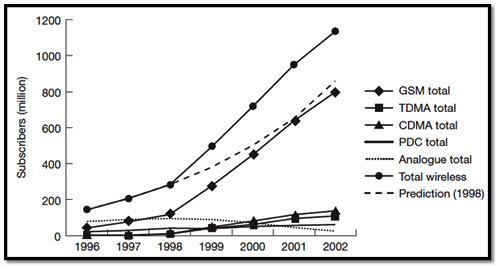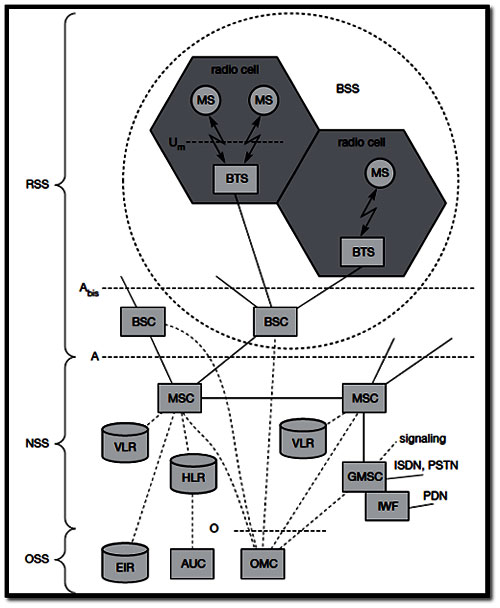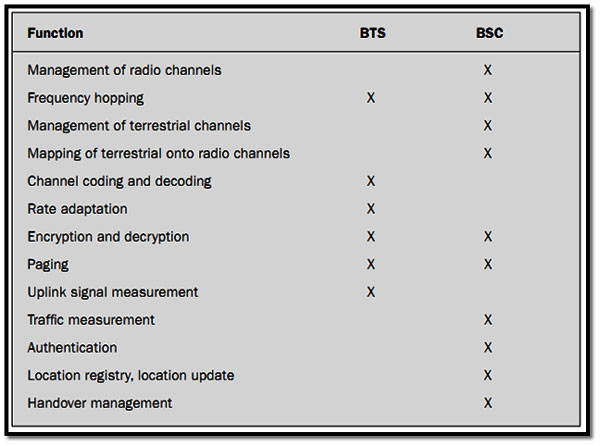GSM Technology
Sakshi Education

GSM, Global System for Mobile Communications, is a standard protocol for digital cellular networks for mobile phones. This technology was developed by the European Telecommunications Standards Institute (ETSI). Till to date, it has become the default global standard for mobile communications with over 90% market share, operating in over 219 countries and territories.
Figure: Worldwide subscribers of different mobile phone technologies
The above figure shows the worldwide count of subscribers to different mobile phone technologies (GSM Association, 2002). The figure combines different versions of the same technology (e.g., GSM working on 900, 1,800, and 1,900 MHz). The above graph shows the successful journey of mobile and wireless communications. Also we can see the dominating progress of GSM above the traditional analog systems is clearly observed.
Characteristics:
GSM services:
GSM provides an amalgamation of voice and data transmission, which makes GSM technology interesting to customers. There are three different categories of services:
A mobile station MS is connected to the GSM public land mobile network (PLMN) via the Um interface.
This network is connected to transit networks, e.g., integrated services digital network (ISDN) or traditional public switched telephone network (PSTN).

Figure: Bearer and Tele services reference model
Bearer services
Bearer services comprise of services that enable the transparent transmission of data between the interfaces to the network. Bearer services permit transparent and non-transparent, synchronous or asynchronous data transmission.
Transparent bearer services use physical layer functions to transmit data. Data transmission has a constant delay and throughput if no transmission errors occur. In such cases forward error correction (FEC), helps to reconstruct original data at times of transmission loses. Depending on the FEC, data rates of 2.4, 4.8, or 9.6kbit/s are possible. This Transparent bearer services makes no attempt to recover the data, which is lost due to interruptions handover.
Non-Transparent bearer services use layer 2 and layer three protocols for error correction and flow control. These services make use of the services offered by the transparent bearer. These services make use of radio link protocol (RLP), this protocol consists of mechanisms of high-level data link control (HDLC), and special selective-reject mechanisms to trigger retransmission of erroneous data. The error bit rate obtained is less than 10–7, but the throughput and delay may contrast up on transmission quality.
Tele Services
The important of services offered by telephone is audio service; this involves mechanism for Secure, high quality service and lossless transmission of data. To offer high-quality digital voice transmission, at least the typical bandwidth of analog phone systems should be of 3.1 kHz.
Another important service is Emergency Number. This service is offered free of cost to the customers to assist in the case of emergency situations.
Short message service (SMS), a non voiceless service, offers customers to send short message not exceeding 160 characters. Today more than 30 billion short messages are transferred worldwide per month! Sending and receiving of SMS is possible during data or voice transmission.SMS service is the only way to reach a mobile phone from within the network. Thus, SMS is used for updating mobile phone software or for implementing so-called push services. Enhanced Message service (EMS) is the advanced version of SMS where one larger messages like images, small videos, ringtones, animated pictures etc. Multimedia Message service (MMS) is another form of EMS.
Supplementary Services:
In addition to tele and bearer services, GSM providers can offer supplementary services. Similar to ISDN networks, these services offer various enhancements for the standard telephony service, and may vary from provider to provider. Typical services are user identification, call redirection, or forwarding of ongoing calls. Standard ISDN features such as closed user groups and multi-party communication may be available. Closed user groups are of special interest to companies because they allow, for example, a company-speci?c GSM sub-network, to which only members of the group have access.
GSM Architecture:
We as a user just get thrilled for getting a voice signal of the one whom you dialed, but we don’t understand the complex mechanism this to happen. This GSM architecture unveils the mechanism between receiver and transmitter. A GSM system consists of three subsystems:
Please refer the figure below for the architecture.

Figure: Functional architecture of a GSM system
Network Subsystem
Mobile Switching Center (MSC)
Switch speech and data connections between:
Three main jobs:
Home Location Registers (HLR):
It contains administrative information of each subscriber and current location of the mobile. It contains all the information about the subscriber, such as subscriber's service profile, location information, and activity status.
Visitor Location Registers (VLR)
It contains selected administrative information from the HLR authenticates the user and tracks which customers have the phone on and ready to receive a call. It periodically updates the database on which phones are turned on and ready to receive calls
Authentication Center (AUC):
The core purpose of AUC is to ensure the security of the data storage location and functional part of the network. It verifies each call, authenticates it and provides the encryption mechanisms to ensure the confidentiality.
Equipment Identity Register (EIR)
EIR is the Database that is used to track handsets using the IMEI (International Mobile Equipment Identity). This comes very handy in case of mobile theft. This is made up of three sub-classes: The White List, The Black List and the Gray List. The AUC and EIR are implemented as stand-alone nodes or as a combined AUC/EIR node.
Basic Features Provided by GSM
Advantages of GSM
Figure: Worldwide subscribers of different mobile phone technologies
The above figure shows the worldwide count of subscribers to different mobile phone technologies (GSM Association, 2002). The figure combines different versions of the same technology (e.g., GSM working on 900, 1,800, and 1,900 MHz). The above graph shows the successful journey of mobile and wireless communications. Also we can see the dominating progress of GSM above the traditional analog systems is clearly observed.
Characteristics:
- Communication: Mobile, wireless communication; support for voice and data services.
- Total mobility: International access, chip-card enables use of access points of different providers.
- Worldwide connectivity: One number, the network handles localization.
- High capacity: Better frequency efficiency, smaller cells, more customers per cell.
- High transmission quality: High audio quality and reliability for wireless, uninterrupted phone calls at higher speeds (e.g., from cars, trains).
- Security functions: Access control, authentication via chip-card and PIN.
GSM services:
GSM provides an amalgamation of voice and data transmission, which makes GSM technology interesting to customers. There are three different categories of services:
- Bearer
- Tele Services and
- supplementary services
A mobile station MS is connected to the GSM public land mobile network (PLMN) via the Um interface.
This network is connected to transit networks, e.g., integrated services digital network (ISDN) or traditional public switched telephone network (PSTN).

Figure: Bearer and Tele services reference model
Bearer services
Bearer services comprise of services that enable the transparent transmission of data between the interfaces to the network. Bearer services permit transparent and non-transparent, synchronous or asynchronous data transmission.
Transparent bearer services use physical layer functions to transmit data. Data transmission has a constant delay and throughput if no transmission errors occur. In such cases forward error correction (FEC), helps to reconstruct original data at times of transmission loses. Depending on the FEC, data rates of 2.4, 4.8, or 9.6kbit/s are possible. This Transparent bearer services makes no attempt to recover the data, which is lost due to interruptions handover.
Non-Transparent bearer services use layer 2 and layer three protocols for error correction and flow control. These services make use of the services offered by the transparent bearer. These services make use of radio link protocol (RLP), this protocol consists of mechanisms of high-level data link control (HDLC), and special selective-reject mechanisms to trigger retransmission of erroneous data. The error bit rate obtained is less than 10–7, but the throughput and delay may contrast up on transmission quality.
Tele Services
The important of services offered by telephone is audio service; this involves mechanism for Secure, high quality service and lossless transmission of data. To offer high-quality digital voice transmission, at least the typical bandwidth of analog phone systems should be of 3.1 kHz.
Another important service is Emergency Number. This service is offered free of cost to the customers to assist in the case of emergency situations.
Short message service (SMS), a non voiceless service, offers customers to send short message not exceeding 160 characters. Today more than 30 billion short messages are transferred worldwide per month! Sending and receiving of SMS is possible during data or voice transmission.SMS service is the only way to reach a mobile phone from within the network. Thus, SMS is used for updating mobile phone software or for implementing so-called push services. Enhanced Message service (EMS) is the advanced version of SMS where one larger messages like images, small videos, ringtones, animated pictures etc. Multimedia Message service (MMS) is another form of EMS.
Supplementary Services:
In addition to tele and bearer services, GSM providers can offer supplementary services. Similar to ISDN networks, these services offer various enhancements for the standard telephony service, and may vary from provider to provider. Typical services are user identification, call redirection, or forwarding of ongoing calls. Standard ISDN features such as closed user groups and multi-party communication may be available. Closed user groups are of special interest to companies because they allow, for example, a company-speci?c GSM sub-network, to which only members of the group have access.
GSM Architecture:
We as a user just get thrilled for getting a voice signal of the one whom you dialed, but we don’t understand the complex mechanism this to happen. This GSM architecture unveils the mechanism between receiver and transmitter. A GSM system consists of three subsystems:
- The radio subsystem (RSS),
- The network and switching subsystem (NSS), and
- The operation subsystem (OSS)
Please refer the figure below for the architecture.

Figure: Functional architecture of a GSM system
- Radio subsystem
Radio subsystem consists of:- Mobile stations (MS)
- Base station subsystem (BSS)
- Base transceiver station (BTS)
- Base station controller (BSC)
- Base station subsystem (BSS)
This is responsible for the communication between the cellular phone network and the network switching subsystem. A GSM network contains many BSSs which are controlled by a base station controller (BSC). The BSS performs all functions necessary to maintain radio connections to an MS, coding/decoding of voice, and rate adaptation to/from the wireless network part. Besides a BSC, the BSS contains several BTSs.
- Base transceiver station (BTS):
A BTS is connected to Mobile station through the interface Um (ISDN U interface for mobile use), and to the Base Station Controller via the Abis interface. It contains antennas, signal processing equipment, amplifiers necessary for radio transmission. Apart from these services following are the functions provided by BTS:- Encoding, encrypting, multiplexing, modulating, and feeding the RF signals to the antenna
- Transcoding and rate adaptation
- Time and frequency synchronizing
- Voice through full- or half-rate services
- Decoding, decrypting, and equalizing received signals
- Random access detection
- Timing advances
- Uplink channel measurements
- Base station controller (BSC):
The BSC basically manages the BTSs or base stations. It reserves radio frequencies, handles the handover from one BTS to another within the BSS, and performs paging of the MS. The BSC also multiplexes the radio channels onto the fixed network connections at the A interface. The functions of BSC include:- BTS handover management
- call setup
- Control of frequency hopping
- Performing traffic concentration to reduce the number of lines from the MSC
- Time and frequency synchronization
- Power management
- Time-delay measurements of received signals from the MS

- Table: Tasks of the BTS and BSC within a BSS
- Mobile stations (MS):
The Mobile Station is made up of two entities:- Mobile Equipment (ME)
- Subscriber Identity Module (SIM)
Mobile Equipment- Produced by many different manufacturers
- Must obtain approval from the standardization body
- Uniquely identified by an IMEI (International Mobile Equipment Identity)
Subscriber Identity Module (SIM)- Smart card containing the International Mobile Subscriber Identity (IMSI)
- Allows user to send and receive calls and receive other subscribed services
- Encoded network identification details
- Protected by a password or PIN
- Can be moved from phone to phone – contains key information to activate the phone
Network Subsystem
Mobile Switching Center (MSC)
Switch speech and data connections between:
- Base Station Controllers
- Mobile Switching Centers
- GSM-networks
- Other external networks
- Heart of the network
Three main jobs:
- Connects calls from sender to receiver
- Collects details of the calls made and received
- Supervises operation of the rest of the network components
Home Location Registers (HLR):
It contains administrative information of each subscriber and current location of the mobile. It contains all the information about the subscriber, such as subscriber's service profile, location information, and activity status.
Visitor Location Registers (VLR)
It contains selected administrative information from the HLR authenticates the user and tracks which customers have the phone on and ready to receive a call. It periodically updates the database on which phones are turned on and ready to receive calls
Authentication Center (AUC):
The core purpose of AUC is to ensure the security of the data storage location and functional part of the network. It verifies each call, authenticates it and provides the encryption mechanisms to ensure the confidentiality.
Equipment Identity Register (EIR)
EIR is the Database that is used to track handsets using the IMEI (International Mobile Equipment Identity). This comes very handy in case of mobile theft. This is made up of three sub-classes: The White List, The Black List and the Gray List. The AUC and EIR are implemented as stand-alone nodes or as a combined AUC/EIR node.
Basic Features Provided by GSM
- Call Waiting: Notification of an incoming call while on the handset
- Call Hold: Put a caller on hold to take another call
- Call Barring: All calls, outgoing calls, or incoming calls
- Call Forwarding: Calls can be sent to various numbers defined by the user
- Multi-Party Call Conferencing: Link multiple calls together
- Calling Line ID: Incoming telephone number displayed
- Alternate Line Service: one for personal calls and one for business calls
- Closed User Group: call by dialing last for numbers
- Advice of Charge: Tally of actual costs of phone calls
- Fax & Data: Virtual Office / Professional Office
- Roaming: services and features can follow customer from market to market
Advantages of GSM
- Crisper, cleaner quieter calls
- Security against fraud and eavesdropping
- International roaming capability in over 100 countries
- Improved battery life
- Efficient network design for less expensive system expansion
- Efficient use of spectrum
- Advanced features such as short messaging and caller ID
- A wide variety of handsets and accessories
- High stability mobile fax and data at up to 9600 baud
- Ease of use with over the air activation, and all account information is held in a smart card which can be moved from handset to handset
Published date : 07 Jul 2015 04:08PM






